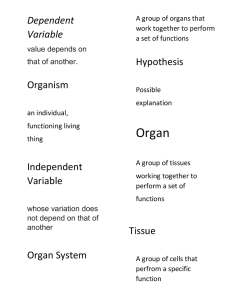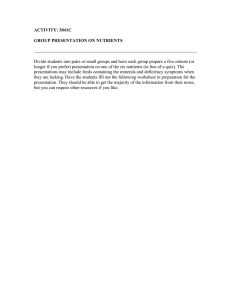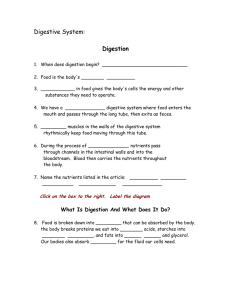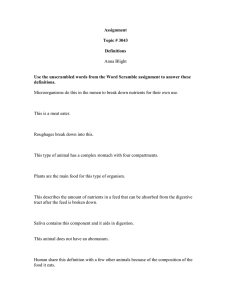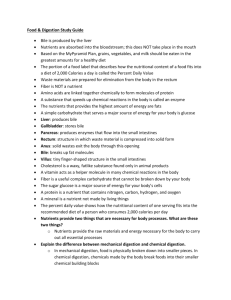The Gastrointestinal System By Jennifer Turley and Joan Thompson © 2016 Cengage
advertisement
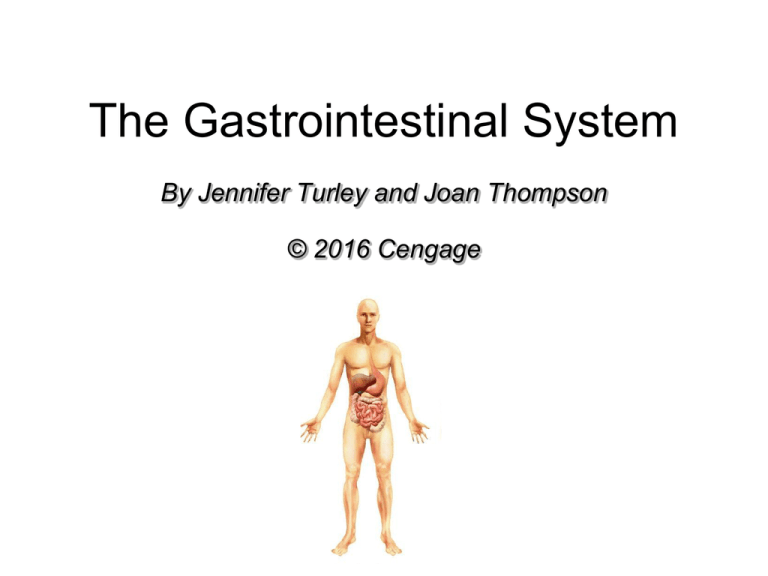
The Gastrointestinal System By Jennifer Turley and Joan Thompson © 2016 Cengage Presentation Overview • The Process • The Organs • Enzymes & Hormones • After digestion: – absorption – transportation – utilization – excretion What is Digestion? • The breaking down of food • Big food parts into smaller ones (mechanical) – Involves muscles and nerves • Big nutrients into smaller ones (chemical) – Involves acid, enzymes, and hormones What is an Enzyme? • Protein that catalyze metabolic reactions, and are necessary for most biochemical reactions to occur. • Digestive enzymes specifically break down food substances. • Examples include: amylase for carbohydrate, protease for protein, and lipase for Lipids/Fat. What is a Hormone? • Chemicals produced by cells (typically in an endocrine gland), and are secreted, then affect the behavior of cells at distal sites in the body. • Examples of hormones in digestion include: cholecystokinin and secretin. The journey begins in the mouth with: • Mechanical digestion: chewing (mastication) • Chemical digestion: saliva (lubrication) and amylase (breaks down digestible carbohydrate) Food becomes bolus The Esophagus • Peristalsis begins. • Peristalsis is: a muscular wave action that occurs throughout the intestinal tract. It is controlled by the central nervous system and facilitates excretion by propelling food stuff through the body. The Stomach • Is a muscular organ & storage reservoir. • Mechanically digests food by mixing & churning. • Chemically digests food with acid and some enzymes (pepsin). • Here, the bolus becomes chyme. The Small Intestine • Duodenum • Jejunum • Ileum Signaling the accessory organs • Why? – For assistance in digesting the food stuff. • How? – By hormones. – The cells of the intestinal wall produce the hormones cholecystokinin and secretin which enter the blood stream and signal the accessory organs. The Accessory Organs • The Liver – Makes bile • The Gallbladder – Stores bile • The Pancreas – Makes enzymes for the chemical digestion of carbohydrates, proteins, and fats – Makes sodium bicarbonate to neutralize stomach acid The Function of Bile Emulsifier Mechanisms of Absorption • Passive (Simple) Diffusion (Transport): Nutrients like water & lipid byproducts pass freely across membranes via a concentration gradient. • Facilitated Diffusion (Transport): Nutrients like water soluble vitamins diffuse across membranes using a specific/selective transport proteins. • Active Transport: Nutrients like glucose & amino acids move across membranes against a concentration gradient using a specific/selective transport protein & energy/ATP. Absorption Sites of Absorption • • • • Duodenum: many nutrients Jejunum: many nutrients Ileum: only selected nutrients Colon (large Intestine): water Transportation of Nutrients • Blood vessels: water soluble nutrients • Lymphatic vessels: fat soluble nutrients Cellular Storage • Short term • Intermediate • Long term Metabolic Usage • Catabolic reactions: Breaking down (things get smaller). Involve hydrolysis reactions. Are degrading or destructive in nature. • Anabolic reactions: Building up (things get bigger). Involve condensation reactions. Are synthesizing or constructive in nature. • Homeostasis: The balance of catabolic and anabolic reactions in a person so a relatively stable internal environment or equilibrium is achieved. Metabolic Examples • What action does the enzyme lipase have on triglycerides: Anabolic, catabolic or neither? • What action does bile have on triglycerides: Anabolic, catabolic or neither? • What action does the hormone secretin have on the liver: Anabolic, catabolic or neither? Excretion • The Kidney: water & water soluble waste. • The Skin: water & water soluble waste. • The Lung: carbon dioxide & water. • The Colon (Large Intestine): Water is removed & waste (bacteria, fiber, sloughed cells, & undigested food) is compacted. Some Summary Points • Chemical & mechanical digestion. • Enzymes vs hormones. • The gastrointestinal tract, organs, and accessory organs. • Nutrient absorption & transportation. • Assimilation of nutrients, storage, & metabolic usage. • Excretion of waste. References for this presentation are the same as those for this topic found in module 3 of the textbook
